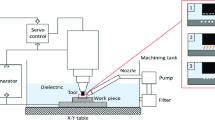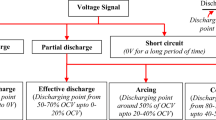Abstract
Electric discharge is a common tool nowadays for machining of materials. It may be through a liquid medium or through air. Any metals, hard alloys, and non-metals can be machined using the energy of electric discharge. In electric discharge machining (EDM), the discharge occurs between two electrodes through a liquid medium and it is applicable only for electrically conducting materials and alloys. In electrochemical discharge machining (ECDM), the medium is an aqueous electrolyte and it is of two types. In the first type, the discharge occurs between two electrodes. One of the electrodes is the workpiece, and the other is the tool. In the second type, the discharge occurs between one electrode and an electrolyte. It is used for electrically nonconducting materials and the discharge energy is utilized maintaining the nonconducting workpiece in proximity of the discharge. All these electrical discharges are transient phenomena and do not result in a stable discharge in the form of arc. The output parameters depend on the discharge energy that requires precise control to maintain the accuracy of the machining. For micromachining, the control of the discharge is paramount both in terms of energy and pattern. Using various shaped tools, machining media with additives, different types of applied potentials, and supporting mechanical motions are some of the attempts made to improve the machining output. Optimization of these parameters for machining particular materials (or alloys) is a popular field of research. The present work is directed toward the investigation of discharge initiation and development by analyzing the cell current and discharge voltage relationship for both EDM and ECDM. The rectangular direct current (DC) pulse with different frequencies and the duty factor (on–off time ratio) are used for investigation. Observations on the voltage–current relationship are made for the external potential prior to discharge at discharge and above the discharge potential. Though the external potential above the discharge voltage is useful for machining, these observations elucidate the mechanism regarding the initiation of the electric discharge under different conditions. The manner of discharge development in dielectrics and electrolytes is observed to be different. This understanding will aid in deciding the design of the discharge circuit including the external potential and its pattern for certain desired outputs in machining.








Similar content being viewed by others
Reference
Boris L (1943) To invert the effect of wear on electric power contacts. Dissertation, The All Union Institute for Electro Technique, Moscow
Kellog HH (1950) Anode effect in aqueous electrolysis. J Electrochem Soc 97(4):133–142
Karafuji H, Suda H (1968) Electrical discharge drilling of glass. CIRP Ann Manuf Technol 16:415–419
Kattan R, Denat A, Lesaint O (1989) Generation, growth, and collapse of vapor bubbles in hydrocarbon liquids under a high divergent electric field. J Appl Phys 66(9):4062–4066
Korobeinikov SM, Melekhov AV, Besov AS (2002) Breakdown initiation in water with the aid of bubbles. High Temp 40(5):652–659
Basak I, Ghosh A (1996) Mechanism of spark generation during electrochemical discharge machining: a theoretical model and experimental verification. J Mater Process Technol 62:46–53
Denat A, Jomni F, Aitken F et al (2002) Thermally and electrically induced bubbles in liquid argon and nitrogen. IEEE Trans Dielectr Electr Insul 9(1):17–22
Sanchez JA, Plaza S, Lopez de Lacalle LN et al (2006) Computer simulation of wire-EDM taper cutting. Int J Comput Integr Manuf 19(7):727–735
Sanchez JA, Pombo I, Cabanes I et al (2008) Electrical discharge truing of metal bonded CBN wheels using single point electrode. Int J Mach Tools Manuf 48:362–370
Chow HM, Yang LD, Lin CT et al (2008) The use of SiC powder in water as dielectric for micro-slit EDM machining. J Mater Process Technol 195:160–170
Patel KM, Pulak M, Pandey M et al (2010) Optimization of process parameters for multi-performance characteristics in EDM of Al2O3 ceramic composite. Int J Adv Manuf Technol 47:1137–1147
Nguyen MD, Rahman M, Wong YS (2012) An experimental study on micro-EDM in low-resistivity deionized water using short voltage pulses. Int J Adv Manuf Technol 58:533–544
Mahardika M, Prihandana GS, Mitsui K (2012) Precision machining by discharge pulse counting methods in micro EDM processes. J Mech Sci Technol 26:3597–3603
Hou P, Guo Y, Shao D et al (2014) Influence of open-circuit voltage on high-speed wire electrical discharge machining of insulating zirconia. Int J Adv Manuf Technol 73:229–239
Nandi D, Basak I (2014) Effect of cell parameters on discharge voltage in electric discharge cell. IPASJ Int J Mech Eng 2(9):32–40
Das D, Nandi D, Basak I (2013) Initiation time for electrical discharge through liquid medium. In: National conference on recent trends in manufacturing science and technology, RTMST-2013, NITTTR, Kolkata, India, pp 143–157
Nandi D, Basak I (2016) Influence of pulse duration on electric discharge in dielectric medium. Int J Innov Res Sci Eng Technol 5(8):15047–15052
Nikalje AM, Kumar A, Srinadh KVS (2013) Influence of parameters and optimization of EDM performance measures on MDN 300 steel using Taguchi method. Int J Adv Manuf Technol 69:41–49
Rajyalakshmi G, Venkata RP (2013) Multiple process parameter optimization of wire electrical discharge machining on Inconel 825 using Taguchi grey relational analysis. Int J Adv Manuf Technol 69:1249–1262
Mustafa AY, Çaydaş U, Hasçalık A (2013) Optimization of micro-EDM drilling of Inconel 718 superalloy. Int J Adv Manuf Technol 66:1015–1023
Coteaţă M, Creţu G (2014) ECDM drilling process analysis via Taguchi method. Appl Mech Mater 657:337–341
Wang F, Liu YH, Zhang YZ et al (2014) Compound machining of titanium alloy by super high speed EDM milling and arc machining. J Mater Process Technol 214:531–538
Funding
Funding was provided by National Institute of Technology Durgapur.
Author information
Authors and Affiliations
Corresponding author
Rights and permissions
About this article
Cite this article
Sindhu, M.K., Nandi, D. & Basak, I. Electric discharge phenomenon in dielectric and electrolyte medium. Adv. Manuf. 6, 457–464 (2018). https://doi.org/10.1007/s40436-018-0221-1
Received:
Accepted:
Published:
Issue Date:
DOI: https://doi.org/10.1007/s40436-018-0221-1




